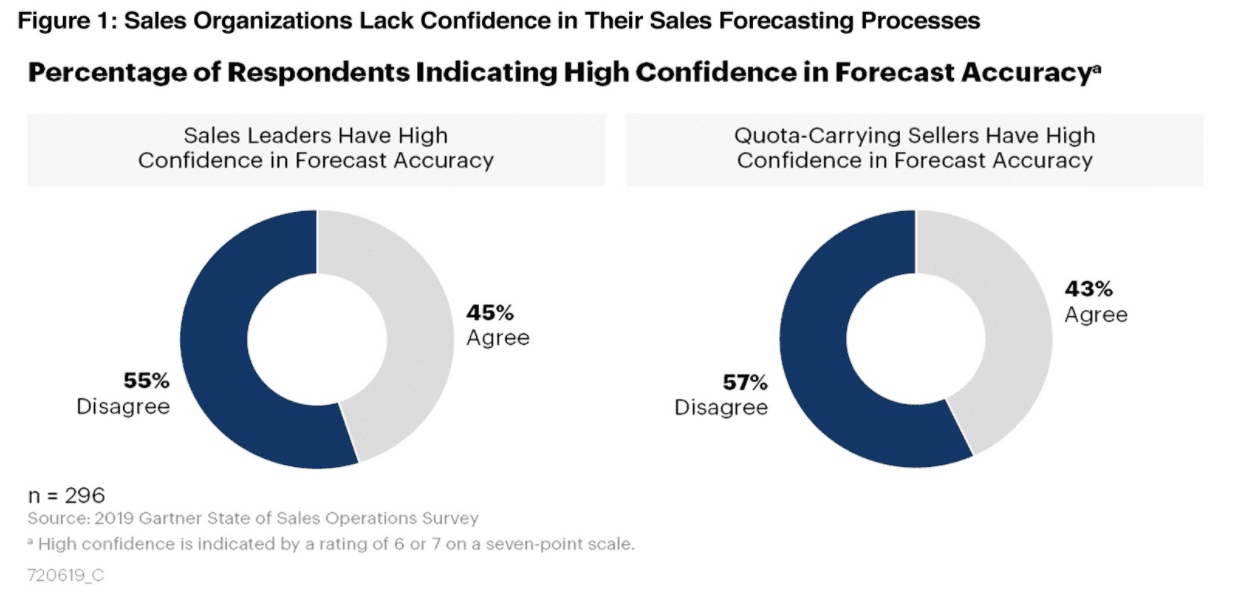In uncertain times like these, business leaders would kill to have predictable revenue. Many of them are still grappling with how to forecast revenue for the next year, which is often the starting point for drawing up annual budgets for the organization. With distributed sales teams, businesses are now relying on their ability to forecast, now more than ever, to drive their entire growth strategy.
Sales forecasting is both a science and an art. Decision makers rely on these forecasts to plan for business expansion and to determine how to fuel the company’s growth. So, in many ways, sales forecasting affects everyone in the organization
Yet for most companies coming up with an accurate sales forecast is still a major challenge. Thanks to inaccurate forecasting methods based on intuition, companies end up having poor visibility into projected sales. According to Clari, a revenue operations platform, 93 percent of sales leaders are unable to forecast revenue within 5 percent, even with two weeks left in the quarter.

When a company constantly misses its sales forecast it can have a negative impact on its valuation over the long term. Exceeding your forecasts isn’t good news either. When you cannot estimate how much revenue you will generate accurately, you can’t hire or invest to keep with the growth and that could lead to several missed opportunities.
Fret not, sales forecasting is no rocket science either. Since you have a ringside view of the business, you probably are in the best place to see where it is going. You just need to put in a repeatable scalable data-driven process in place.
Why Accurate Sales Forecasting Matters
- A sales forecast helps every business make better business decisions. It helps in overall business planning, budgeting, and risk management.
- Sales forecasting allows companies to efficiently allocate resources for future growth and manage its cash flow.
- Sales forecasts help sales teams achieve their goals by identifying early warning signals in their sales pipeline and course-correct before it’s too late
- Sales forecasting also helps businesses to estimate their costs and revenue accurately based on which they are able to predict their short-term and long-term performance.
Six Factors to Keep in Mind for Accurate Sales forecasting
Since sales forecasting plays such a critical role in a company’s growth, here are a couple of pointers that can help improve the accuracy of your forecasts.
Look at Historic Data and Reports
Past sales performance is a good leading indicator of future sales performance. Historical conversion rates tell you how many prospects, teams, or individuals were able to convert over a given period of time. Understanding your conversion rates at each stage of your sales funnel will give you a better understanding of what kind of future sales your team can achieve and the pipeline coverage you will need to hit those targets.
For example, if you want to close 100 deals this year, and your sales team closes 20% of deals with leads who have gone through a product demo and 10% of leads that agree to sign up for a demo, then you have to generate 5000 leads to close those 100 deals. (5000 x 20% x 10% = 100 deals).
So you can improve the accuracy of your sales forecasts by analyzing the deals in your pipeline and the performance of your sales reps based on the historical data.
Data plays a crucial role in improving the accuracy of your forecasts and building predictable revenue. Chargebee’s Revenuestory feature gives you a 360-degree view of your business and better control of your business metrics. The sales watch dashboard allows the sales team to identify which industries, geographies, plans, and even sales reps contribute to the most revenue.
Define the Sales Process
You need to start with a clearly defined sales process accounting for each opportunity stage in the sales funnel. These stages need to be defined by the buying process and clearly documented so everyone knows when and how to count the leads when they enter or drop-off the funnel. Document the steps in the sales process that can be used when converting a lead to a customer, clearly defining how to qualify a lead, an opportunity, a prospect, and a close. If these standards are not communicated, each member will come up with their own interpretation of each stage in the sales process. This will lead to inconsistent data and impact your ability to predict the likelihood of an opportunity closing.

Invest in a CRM
A sales forecasting CRM helps sales teams predict future revenue growth more accurately as you can adjust your pipeline estimates based on lead confidence. It also helps you streamline the sales process as it offers a lot of insights into the team’s productivity, success rate, and bottlenecks in the sales process. CRM solutions such as Salesforce, Freshsales, or Hubspot will help your sales reps track opportunities and help you identify top lead sources. This helps you optimize your resources by allocating more funds toward your more profitable sales activities. To improve the efficiency of your sales reps, ensure that your CRM is integrated with your finance system. The two systems in sync will ensure sales reps have access to more contextualized information about their customers leading to smoother workflows and better client relationships. We have integrated with Salesforce to let your sales team manage their entire cycle from quotes to orders to billing and renewals without leaving the comfort of your CRM.
Pick a Sales Forecasting Method
After establishing your sales process and having a CRM in place, you need to choose a sales forecasting method. The forecasting model you choose needs to factor in the maturity of your business, the size of your sales team and pipeline, the quality of your sales data, and how meticulously you track it. You can learn more about the various sales forecasting methods here
Consider Both External and Internal Factors
When drawing up your annual forecast, you need to factor in several external factors such as changing economic conditions, market competition, and the seasonality of the business. So sales forecasting is never a one-time activity that you are done and dusted with at the beginning of the year. Unpredictable events such as global pandemics, economic crises can turn your forecast on its head, so in a volatile environment, it’s better to re-forecast at the end of every quarter and monitor the progress on a day- to- day basis. Apart from external factors, internal factors such as beefing up your sales teams, change in pricing, promotional strategy, new product launches also need to be worked into your forecasts.
Here’s a helpful video by Matt Wensing, CEO of Summit, giving out actionable tips on how to re-forecast & build revenue projections to tackle uncertainties.
Key metrics that are used in sales forecasting
Here are some basic sales metrics to gauge the performance and progress of your sales teams towards achieving the overall revenue goals. The sales metrics help identify pain points in the sales process, identify and incentivize reps who have been outperforming, and the ones that need a little help in achieving their targets.
Quota
Sales quotas are targets assigned to your sales reps and teams that need to be met over a specific period of time, say monthly, quarterly, or annual. These targets roll up into the overall revenue goal for the organization. Quotas help in measuring individual performance and are fixed based on the sales reps’ experience, the product, and the region they operate in. It forms the base for all the other sales metrics and serves as a motivational tool for the sales rep since the attainment or exceeding the quota results in a performance bonus
Attainment
Attainment is an important metric that tracks the number of deals closed against the quota assigned. It needs to be tracked on a day- to- day basis to ensure that the sales team is consistently closing deals through the quarter and there is no last minute scramble to reach targets at the end of the quarter. Going a little deeper, you also want to look into deal slippage which is nothing but the number of deals that were committed but failed to close during the forecasted period. Not only can the team focus on closing it the first thing the next quarter but understanding your deal slippage rate will help you bake that into your forecast and plan for extra coverage.
Pipeline Coverage
Pipeline coverage tells how much buffer you have in your sales pipeline to achieve your sales target. For instance, if you have a quarterly sales target of around $1 million and you have a deal pipeline of $ 3 million, you’d have 3X pipeline coverage putting you in a rather comfortable position to reach your quarterly target. Tracking how much pipeline you needed historically to reach your target will give a good idea of how much pipeline you will need to achieve your future targets. Taking it a notch higher, you also may want to establish next quarter pipeline targets based on historical data. This will let your revenue teams know what kind of deal pipeline they should build during the current quarter so they can begin the next one on a strong footing.
Sales Activity Data
Sales activity data includes any activity that a member of your sales or marketing team engages with a prospect or customer. This could include emails, calls, marketing campaigns during the sales process. It tells you everything that happened across days, weeks or months leading up to the sale and helps in understanding the process that went behind closing the deal. It increases the effectiveness of the sales process by letting you know what content pieces or marketing campaigns resonated with customers. Measuring this data can tell the sales teams whether a prospect is truly engaged and access the health of the deal more accurately.
Sales forecasting drives all your strategic decisions and affects almost every department in your company. For instance, the finance department uses it to draw up its quarterly and annual investments. HR uses the forecast to align its hiring plans to the company’s expansion plans, product managers use it to plan the demand for new products. As the business landscapes continue to change quite rapidly, your ability to forecast accurately has become more important than ever. The more accurate your sales forecasts, the more agile you are to adapt to changing scenarios. Accurate sales forecasts are critical for building an enduring business. So ensure you have a rock-solid sales forecasting process in place because the company’s future depends on it.

